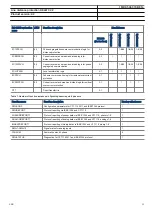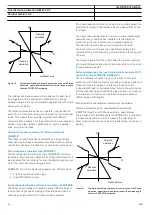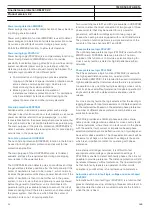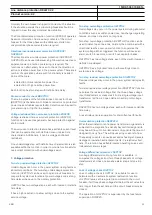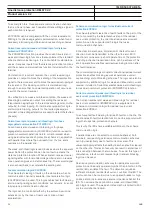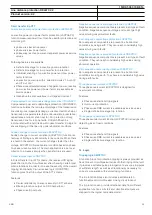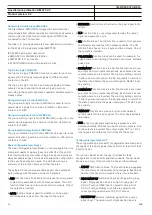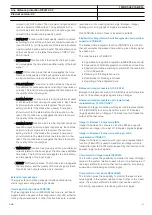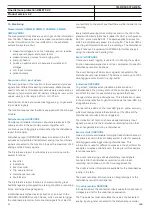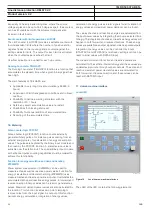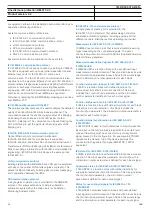
5. Wide area measurement system
Synchrophasor report, 8 phasors
Configuration parameters for IEEE1344 and C37.118 protocol
PMUCONF
The IED supports the following IEEE synchrophasor standards:
• IEEE 1344-1995 (Both measurements and data
communication)
• IEEE Std C37.118-2005 (Both measurements and data
communication)
• IEEE Std C37.118.1–2011 and C37.118.1a-2014
(Measurements)
• IEEE Std C37.118.2-2011 (Data communication)
PMUCONF contains the PMU configuration parameters for
both IEEE C37.118 and IEEE 1344 protocols. This means all the
required settings and parameters in order to establish and
define a number of TCP and/or UDP connections with one or
more PDC clients (synchrophasor client). This includes port
numbers, TCP/UDP IP addresses, and specific settings for
IEEE C37.118 as well as IEEE 1344 protocols.
Protocol reporting via IEEE 1344 and C37.118 PMUREPORT
The phasor measurement reporting block moves the phasor
calculations into an IEEE C37.118 and/or IEEE 1344
synchrophasor frame format. The PMUREPORT block contains
parameters for PMU performance class and reporting rate, the
IDCODE and Global PMU ID, format of the data streamed
through the protocol, the type of reported synchrophasors, as
well as settings for reporting analog and digital signals.
The message generated by the PMUREPORT function block is
set in accordance with the IEEE C37.118 and/or IEEE 1344
standards.
There are settings for Phasor type (positive sequence, negative
sequence or zero sequence in case of 3-phase phasor and L1,
L2 or L3 in case of single phase phasor), PMU's Service class
(Protection or Measurement), Phasor representation (polar or
rectangular) and the data types for phasor data, analog data
and frequency data.
Synchrophasor data can be reported to up to 8 clients over TCP
and/or 6 UDP group clients for multicast or unicast
transmission of phasor data from the IED. More information
regarding synchrophasor communication structure and
TCP/UDP configuration is available in Application Manual under
section C37.118 Phasor Measurement Data Streaming
Protocol Configuration.
Multiple PMU functionality can be configured in the IED, which
can stream out same or different data at different reporting
rates or different performance (service) classes.
6. Current protection
Instantaneous phase overcurrent protection PHPIOC
The instantaneous three phase overcurrent function has a low
transient overreach and short tripping time to allow use as a
high set short-circuit protection function.
Directional phase overcurrent protection, four steps OC4PTOC
Directional phase overcurrent protection, four steps
(OC4PTOC) has an inverse or definite time delay for each step.
All IEC and ANSI inverse time characteristics are available
together with an optional user defined time characteristic.
The directional function needs voltage as it is voltage polarized
with memory. The function can be set to be directional or non-
directional independently for each of the steps.
A second harmonic blocking level can be set for the function
and can be used to block each step individually.
Instantaneous residual overcurrent protection EFPIOC
The Instantaneous residual overcurrent protection (EFPIOC)
has a low transient overreach and short tripping times to allow
the use for instantaneous earth-fault protection, with the reach
limited to less than the typical eighty percent of the line at
minimum source impedance. EFPIOC is configured to measure
the residual current from the three-phase current inputs and
can be configured to measure the current from a separate
current input.
Directional residual overcurrent protection, four steps
EF4PTOC
Directional residual overcurrent protection, four steps
(EF4PTOC) can be used as main protection for phase-to-earth
faults. It can also be used to provide a system back-up, for
example, in the case of the primary protection being out of
service due to communication or voltage transformer circuit
failure.
EF4PTOC has an inverse or definite time delay independent for
each step.
All IEC and ANSI time-delayed characteristics are available
together with an optional user-defined characteristic.
EF4PTOC can be set to be directional or non-directional
independently for each step.
IDir, UPol and IPol can be independently selected to be either
zero sequence or negative sequence.
A second harmonic blocking can be set individually for each
step.
Directional operation can be combined together with the
corresponding communication logic in permissive or blocking
teleprotection scheme. The current reversal and weak-end
infeed functionality are available as well.
1MRK 506 372-BEN -
Line distance protection REL670 2.2
Product version: 2.2
ABB
31
Содержание RELION REL670
Страница 1: ...RELION 670 SERIES Line distance protection REL670 Version 2 2 Product guide...
Страница 149: ...149...







